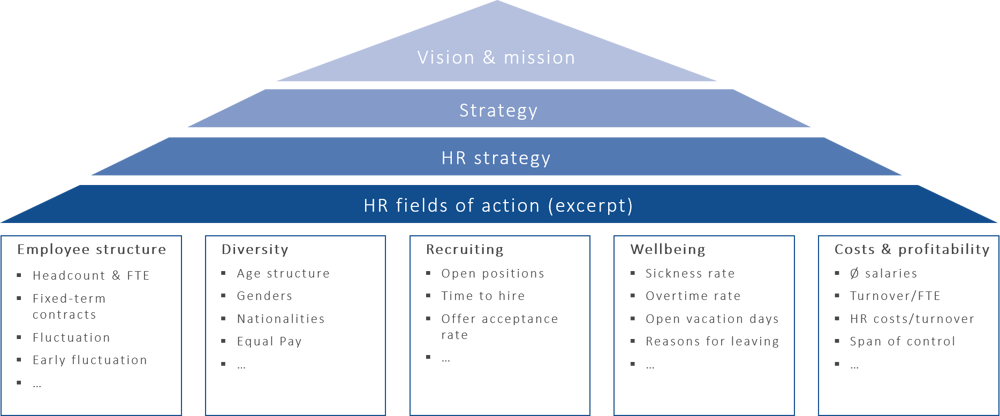Dynamic, complex and confusing market developments, a shortage of skilled workers and demographic change – the current economic and social changes are presenting companies with major challenges. This also has an enormous impact on companies’ HR work.
How HR Analytics contributes to achieving your business goals
In order to remain competitive, targeted, effective personnel steering is essential. A powerful HR Analytics concept can effectively support personnel steering. Aspects such as resources, structures, costs, employee satisfaction and recruiting must be taken into account. A lot of key figures can be determined for these topics. What should the focus be when considering KPIs? Or to put it another way: What should be the focus of a contemporary personnel steering?
Deriving HR KPIs from the corporate strategy
HR work and HR Analytics are not an end in themselves, but always pay off in terms of achieving the company’s goals. It is therefore crucial that the HR strategy – and subsequently also the HR key figures – are aligned with the corporate strategy.
First, the following fundamental questions should be answered:
-
What does the HR strategy aligned with the corporate strategy look like?
-
Which HR objectives and fields of action can be derived from it?
-
What key figures are needed to achieve the HR objectives?
If the company is aiming for rapid growth, the focus will be on recruiting and employee retention. If, on the other hand, the company is in a phase of consolidation and securing profits, the focus is more on optimizing the personnel structure. Regardless of the strategy and the respective market situation, there are certain key topics that all companies should address and to which HR Analytics contributes significantly.

The fields of action in HR are derived from the overarching HR and corporate strategy.
Focus on employer attractiveness
The shortage of skilled workers and the changing expectations of employees represent a particular challenge for companies. In order to be successful in the competition for talent and to strengthen employee loyalty, a high level of attractiveness as an employer is essential. Companies should secure growth opportunities through credibility and increase their attractiveness to the target group of applicants through positive communication of their own values.
HR Analytics makes an important contribution here by analyzing the expectations and needs of the target group. It is important to focus on both internal and external perceptions – on the one hand through employee surveys and feedback processes, and on the other hand by analyzing external platforms such as kununu. In this way, internal and external perceptions can be compared and measures can be derived to continuously improve the company’s own attractiveness as an employer.
Focus on ESG and sustainability
The importance of Environmental, Social & Governance (ESG) and sustainability issues for companies can already hardly be overestimated. In the coming years, their importance will increase even further. Investors are increasingly taking ESG criteria into account when deciding on their investment strategies. Workers are increasingly using sustainability criteria when selecting their future employer.
What role do personnel steering and HR Analytics play in this context? Social issues and good governance are important components of ESG and sustainability. So it’s about issues like diversity and inclusion, training and development, employee satisfaction and health, and last but not least equal pay. Key figures from the various fields of action mentioned are relevant for the assessment. And it will be important that the key figures are audit-proof when they are presented to an auditor, for example.
Use of modern HR systems as a success factor
In many HR departments, a large number of different systems are in use to meet the various requirements. This leads to considerable effort and challenges in terms of consolidation and the quality of the respective data for reliable reporting. Because they have grown historically, the efforts are often not questioned. However, in order to make decisions reliably and on the basis of quickly available, valid data, a modern HR tool with sufficient analysis functions is critical to success and indispensable.
Sensitive topic of participation
The participation of employee representatives is rightly regarded as an extremely sensitive topic. This regularly leads to certain measures not being tackled or not being sufficiently communicated to the employee representatives. In doing so, however, companies commit a cardinal error that must be avoided at all costs.
After all, there is nothing fundamentally wrong with processing personal (employee) data. What is important is that the collection and processing are carried out in compliance with data protection regulations and for a specific purpose. The use of modern personnel systems and a reliable data protection concept ensure data protection. The specific purpose is derived from the clean derivation of the purpose from the corporate and HR objectives as described above.
Conclusion: Increased importance for HR Analytics
Personnel steering can only be successful if the HR-related goals are in line with the overarching corporate strategy. The HR department must translate the company’s strategic goals into its HR objectives and derive effective measures from them in order to achieve the goals. Sustainability goals in particular will become even more prominent in the future. Companies should therefore consider them at an early stage as part of their personnel steering. Overall, the requirements in the area of personnel steering will continue to increase – and with them the importance of HR Analytics in order to master the challenges in terms of corporate success.
![IBacademy_Logo_blau[496] IBacademy_Logo_blau[496]](https://www.ibsolution.com/hs-fs/hubfs/IBacademy_Logo_blau%5B496%5D.jpg?width=200&name=IBacademy_Logo_blau%5B496%5D.jpg)




